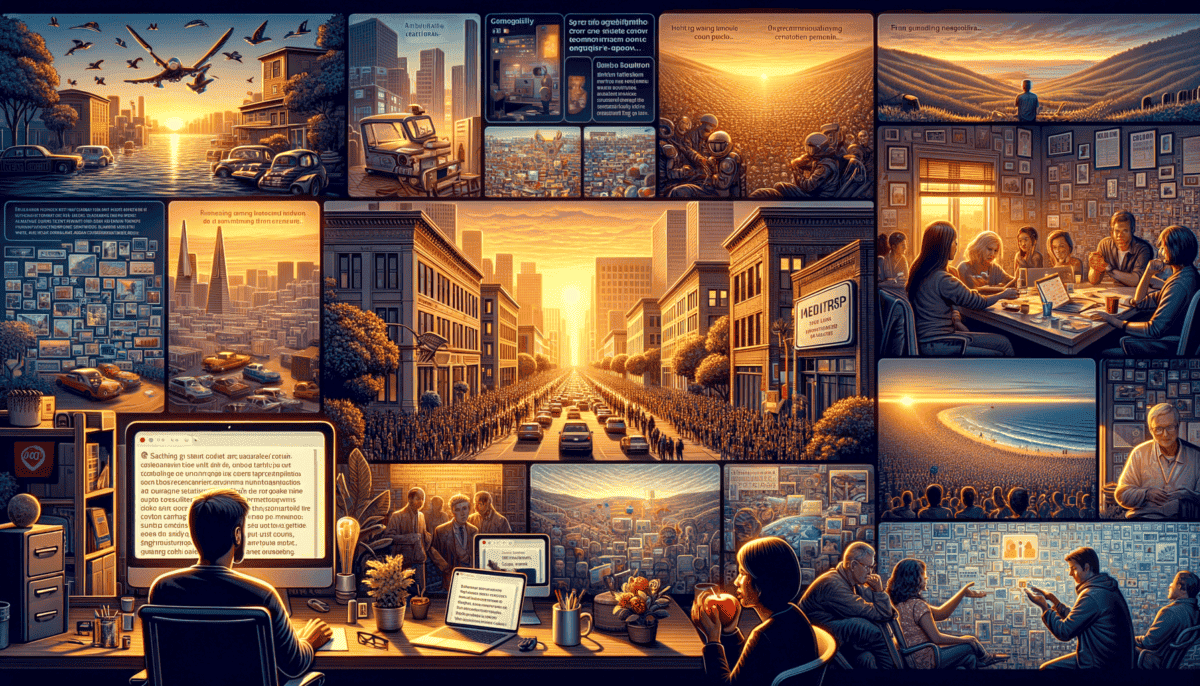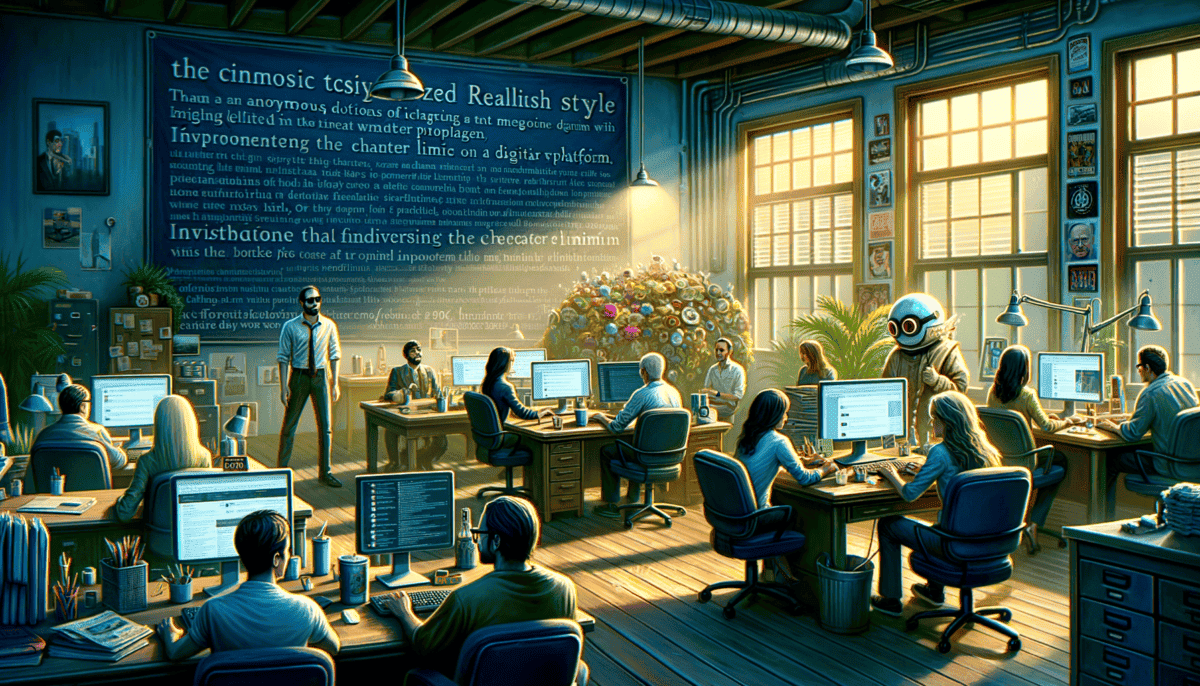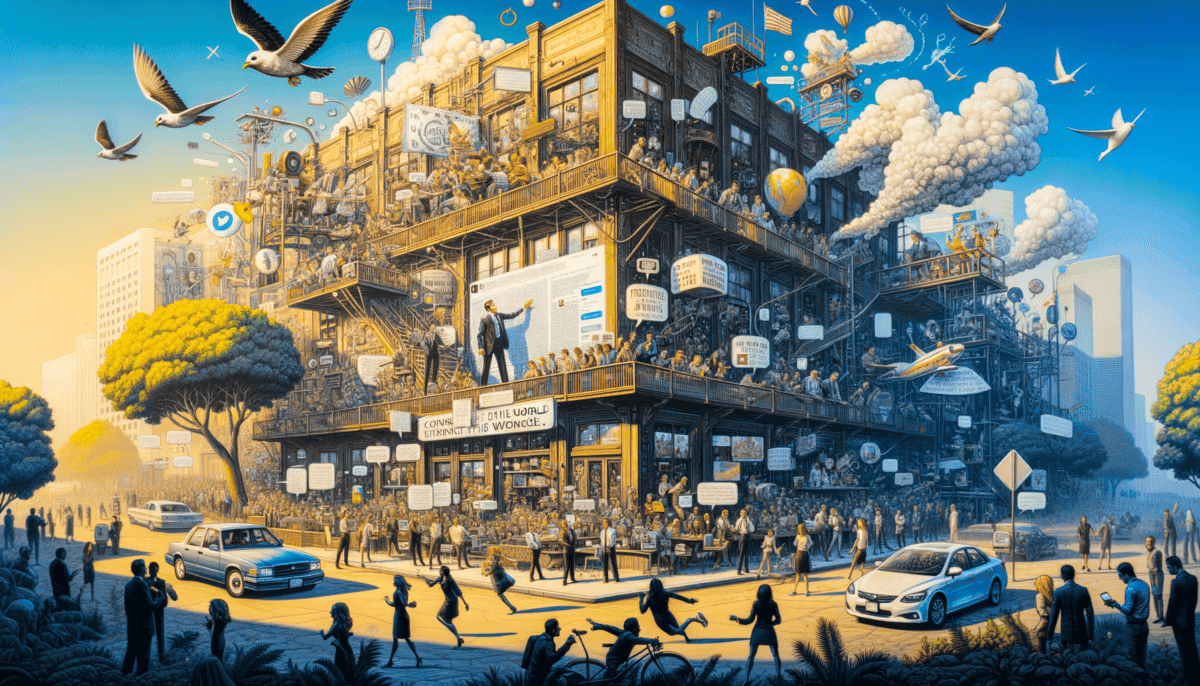The Spark of an Idea
On a sunny day in San Francisco, Jack Dorsey sat at his desk. He had a big dream. He wanted to make a new way for people to talk to each other on the internet.
"What if we could send short messages to lots of people at once?" Jack asked his friends at work. He drew his idea on a small whiteboard.
His friend Noah looked at the drawing. "Like text messages, but for everyone to see?"
"Yes!" Jack smiled. "But shorter and faster!"
Jack and his small team worked in a tiny office. They had computers, snacks, and lots of coffee. ☕ The room buzzed with excitement as they typed and talked.
"But how long should the messages be?" Biz Stone, another friend, asked.
Jack thought hard. "Let's make them short – just 140 characters."
"Why 140?" someone asked.
"Because phone text messages have a limit of 160 characters," Jack explained. "We'll save 20 characters for usernames!"
“If you can’t say it in 140 characters, maybe it’s not worth saying,” Jack joked. But he was also serious.
In 2006, they built their first test. Jack sent the very first tweet: "just setting up my twttr"
The team watched as the message appeared on their screens. It was like magic!
Making It Work
They faced many problems. Sometimes the website would crash. The screen would show a picture of a whale – they called it the "Fail Whale."
"We need to make it stronger," Jack told his team. They worked day and night to fix problems.
People started trying the new site. They liked sending short messages. It was fun to see what others were saying!
• Short messages anyone could read
• Easy to use on phones
• Fast way to share news
• Fun to follow friends
The team kept working hard. They made the website better every day. More and more people joined.
"Look!" Biz shouted one day. "A thousand new people joined today!"
Jack smiled. His small idea was growing bigger. People were using Twitter to share news, tell jokes, and talk to friends.
The Bird Takes Flight
They chose a little blue bird as their symbol. "It's perfect," Jack said. "Birds tweet to talk to each other, just like people on Twitter!"
The office grew busier. More people came to work on Twitter. They needed bigger rooms and more computers.
Every day, something new happened. Someone would discover a new way to use Twitter. People shared pictures, made new friends, and told stories – all in tiny messages.
"We're changing how people talk to each other," Jack told his team. "One tweet at a time."
At night, Jack would look at his computer screen. Millions of little messages flew back and forth. His idea had become real. It was just the beginning of something big. Something that would change how people around the world talk to each other.
The little blue bird was ready to soar higher than anyone imagined.
Growing Pains and Global Connection
Twitter was growing fast! But with more people joining every day, things got tricky. The website kept crashing, and the Fail Whale appeared more often.
“Our servers can’t keep up!” said Biz, watching the error messages pop up.
Jack and his team worked extra hard. They needed to make Twitter stronger. It was like building a bigger boat while sailing across the ocean!
Famous Friends Join the Fun
One day, a famous person joined Twitter. It was Ashton Kutcher! He started sharing messages with his fans.
“Look!” shouted Noah. “Other celebrities are joining too!”
Soon, movie stars, singers, and even the President wanted to be on Twitter. They could talk directly to people all over the world!
“Twitter is like having a conversation with the whole world,” said Oprah Winfrey when she sent her first tweet.
Breaking News Breaks Through
Something unexpected happened in 2009. A plane landed in the Hudson River in New York. ✈️ Before TV news could tell the story, someone on the plane shared it on Twitter!
People realized Twitter could share news faster than TV or newspapers. When big things happened, people went to Twitter first.
• Sharing breaking news
• Talking to famous people
• Meeting new friends
• Telling funny jokes
• Sharing pictures
Growing Around the World
Twitter wasn’t just for people in America anymore. People in Japan loved it! Then people in Brazil started using it. Soon, people in every country were tweeting.
“We need to make Twitter work in different languages,” Jack said. The team worked hard to translate everything.
Some countries had their own Twitter stars. In South Korea, K-pop singers became Twitter famous. In India, cricket players had millions of followers.
Helping During Hard Times
When earthquakes or storms happened, people used Twitter to ask for help. During fires or floods, Twitter helped people stay safe.
“Twitter is becoming more than just fun messages,” Biz said. “It’s helping people when they need it most.”
Teachers used Twitter to share lessons. Scientists talked about their discoveries. Doctors shared important health information.
New Features, New Fun
The team kept adding new things to make Twitter better:
They added the @ symbol to talk to people directly. The # hashtag helped people find posts about the same topic. People could share pictures and videos too!
“It’s like our little bird is learning new tricks,” Jack smiled.
But sometimes people weren’t nice on Twitter. The team had to make rules to keep everyone safe. They wanted Twitter to be a happy place.
By 2010, millions of people were using Twitter every day. The little messaging app had grown into something huge. And it was still growing!
The world was getting smaller, one tweet at a time. People who lived far apart felt like neighbors. They shared jokes, helped each other, and made friends across oceans.
But bigger changes were coming. The 140-character limit that started it all was about to face its biggest test…
The 140-Character Challenge
Every tweet had to be short – just 140 characters! That’s about as long as this sentence. People had to be creative to say what they wanted.
“Why 140?” asked Sarah, a new Twitter user.
“It’s like sending a text message,” explained Jack. “We wanted tweets to be quick and easy to read!”
Getting Creative
People found clever ways to write short messages. They made up new words and used shorter spellings:
“b4” instead of “before”
“gr8” instead of “great”
“u” instead of “you”
“It’s like solving a puzzle every time you tweet!” said Tom, a happy Twitter user.
Short and Sweet Success
Some people thought short messages were better! They learned to say more with less words.
News reporters had to make headlines shorter and clearer. Teachers shared quick tips that were easy to remember. Even the President had to keep messages short!
• Using numbers (2 not two)
• Skipping some words
• Making abbreviations
• Using emojis
• Writing shorter words
Emoji Power
Pictures say a thousand words! People started using emojis to save space. A heart ❤️ meant “love.” A smile showed happiness. A thumbs up meant “good job!”
“Emojis help us say more without using lots of words,” said Maria, who loved using them in her tweets.
New Language Fun
Twitter created new ways to talk! Special words became popular:
Tweet – a message on Twitter
Hashtag # – to group similar messages
Handle @ – to talk to someone
RT – to share someone’s message
Space Problems
Sometimes 140 characters wasn’t enough. People had big ideas to share! They would write many tweets in a row, called a “thread.”
“1/4 Starting my story…”
“2/4 Here’s what happened…”
“3/4 Then this happened…”
“4/4 The end!”
But some users got frustrated. They wanted more space to write. Pictures and links took up precious characters too!
Making It Work
The Twitter team watched how people used the platform. They saw users finding smart solutions to the character limit.
“Our users are so creative!” said Biz. “They’re inventing new ways to talk every day!”
Schools started teaching about writing clear, short messages. Businesses learned to make their ads shorter and better.
The 140-character limit changed how people wrote online. Short messages became popular everywhere – even on other apps!
But something big was about to change. People wanted more space to write. The Twitter team had a big decision to make…
Breaking Free: The 280-Character Era
The big day came in 2017! Twitter made a huge change that made everyone excited.
“Guess what?” announced Sarah from the Twitter team. “You can now write longer tweets!”
Happy Users
People were so happy! Now they could say more in one tweet.
“Finally! I can write complete sentences!” tweeted Mark, a happy user. “No more cutting words or using weird shortcuts!”
Teachers could explain things better. News reporters could share more details. Everyone had more room to tell their stories!
New Ways to Talk
With more space, people started writing differently:
• Writing full sentences
• Using proper spelling
• Adding more details
• Being more clear
• Making fewer mistakes
Making Things Clear
Lucy, a teacher, was very happy. “Now I can explain math problems without splitting them into many tweets!”
News stations could give more information about important events. Doctors could share better health tips. Scientists could explain their discoveries better.
Around the World
The bigger space helped people who spoke different languages too!
“Some languages need more space than English,” explained Tom from Twitter. “Now everyone can say what they want to say!”
Japanese users could write whole sentences. Chinese writers could share more characters. Arabic speakers had room for better translations.
Still Short and Sweet
Even with more space, most people kept their tweets short! They learned that shorter messages were often better.
“Just because we can write more doesn’t mean we always should,” said Maria, who still loved writing quick messages.
Making Connections
The bigger space helped people connect better. They could:
✨ Tell better stories
️ Have nicer conversations
Share clearer information
❤️ Express feelings better
Help others more easily
Business owners were happy too! “Now we can answer customer questions properly,” said Jake, who ran a small shop.
Looking Forward
Twitter kept getting better! More people joined every day. They shared ideas, made friends, and learned new things.
“The 280 characters changed everything,” said Lisa, who used Twitter every day. “It’s like having better conversations with everyone!” ️
But this was just the start. Twitter was about to face bigger changes and challenges. A new chapter in its story was beginning…
The Voice of Change
Twitter became more than just a place to chat. It turned into a powerful tool for change!
Speaking Up
One day, Maria saw something amazing on Twitter. “Look!” she told her friend Alex. “People are using Twitter to help save the rainforest!”
“When we work together on Twitter, we can make big changes happen!” Maria smiled. “It’s like having a superpower!”
Making a Difference
Twitter helped people in many ways:
• Sharing important news fast
• Helping during emergencies
• Standing up for good causes
• Connecting people who need help
• Making leaders listen to people
Breaking News
When big things happened, Twitter was the first to know!
“I learned about the big storm coming from Twitter,” said Tom. “It helped me get ready in time!”
Fighting for Good
People used Twitter to stand up for what’s right. Sarah saw this happen in her town.
“When our park was going to be torn down, we tweeted about it,” she said. “Soon, everyone helped save it!”
Helping Others
Twitter became a place where people could ask for help. And help came fast!
Like when Jake’s dog got lost: “I posted a picture on Twitter, and within hours, someone found him!”
Watching Out
But not everything on Twitter was good. Sometimes people shared wrong information.
“We need to be careful what we believe,” taught Ms. Rodriguez, a school teacher. “Always check if something is true!”
Free Speech Friends
Twitter wanted everyone to speak freely, but safely too. It was like a big playground with rules to keep everyone happy.
“We want people to share ideas,” said a Twitter worker. “But we also want everyone to feel safe.”
Around the Globe
Twitter connected people from everywhere!
Lily in New York could talk to Sam in Tokyo. Carlos in Brazil could share pictures with Emma in Australia.
Making History
Big moments in history happened on Twitter:
✨ People organized peaceful marches
Communities came together after storms
Students shared important messages
⭐ Heroes got help to people in need
Learning Together
Twitter became a giant classroom where everyone could learn new things!
“I learned how to grow tomatoes from someone in Italy!” laughed David. “Now my garden is full of them!”
But more changes were coming. A very rich man named Elon Musk had big plans for Twitter. The little blue bird was about to fly in a new direction…
A New Chapter Begins
The little blue bird that everyone knew was about to change forever!
The Big Change
One sunny morning, everyone woke up to big news. Elon Musk, who builds cool rockets and electric cars, bought Twitter!
“Time for Twitter to become something even bigger!” Elon said with a smile. “Let’s call it X!” ✨
Goodbye Little Bird
The blue bird that everyone loved flew away. In its place came a shiny new X!
“It looks different,” said Lucy, looking at her phone. “But we can still talk to all our friends!”
New Adventures
X started adding cool new things:
• Sending money to people
• Watching live shows
• Playing games together
• Shopping for fun things
Growing Together
People started using X in new ways. Tommy used it to sell his homemade cookies!
“Now I can talk to my customers and sell cookies all in one place!” Tommy said happily.
Looking Forward
Everyone wondered what X would do next. Would there be flying emoji? Virtual reality chats? Space tweets?
“The future is so exciting!” said Maya, posting on X. “I can’t wait to see what happens!”
Lessons Learned
Through all the changes, people learned important things:
Small ideas can grow into big things
❤️ Friends can be made anywhere
The world feels smaller when we’re connected
✨ Change can be good and fun
The Journey Continues
From a tiny blue bird to a mighty X, the story keeps going. Every day, millions of people share their thoughts, dreams, and stories.
Just like Emma, who posts every morning: “Each day on X is a new adventure! Who knows what amazing things we’ll discover today?”
And so, the platform that started with 140 characters grew into something bigger than anyone imagined. It showed us that when people come together, even the smallest tweet can change the world.
The End… or is it just the beginning of something even more amazing? Keep watching X to find out! ✨






